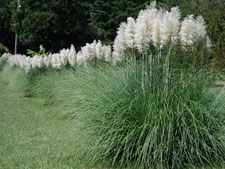Resource Library
Plant of the Week: Pampas Grass
The University of Arkansas System Division of Agriculture does not promote, support or recommend plants featured in "Plant of the Week." Please consult your local Extension office for plants suitable for your region.
Plant of the Week
Pampas Grass
Latin: Cortaderia selloana

In the olden days, many warm weather plants were seldom seen in northern Arkansas, but now these warm weather refugees are commonplace in our landscapes.
The fall flowering pampas grass (Cortaderia selloana) is - according to the books - a zone 8 plant only suitable for south Arkansas. But during the past decade it has become commonplace here in the wintery north and clumps are attaining sufficient size to make good displays.
Pampas grass is native to Argentina and southern Brazil and produces 5-foot long, rather stiff but gracefully arching serrate margined leaves. Unlike the common name suggests, it doesn’t grow in open grasslands but in the mountainous foothills of the Andes. The genus name is from an Argentine name which means “cutting,” an early recognition of the sharp edges of the leaves.
The foliage is evergreen through the winter in mild areas with old leaves tattered and worn by spring when new leaves appear. Plants are hardy to about 10 degrees with clumps only killed when the ground freezes sufficiently deep to kill the crown.
During the summer, pampas grass is a large mound of graceful, medium green foliage that gets larger each year, sometimes forming crowns 5 feet or more across. In the autumn, it shoots up long, erect, silvery feather duster plumes that may be as much as 2 feet in length. Pampas grass is dioecious with individual clumps being either male or female. Female plants are most often grown as ornamentals because the flower heads are more fluffy and airy. Other colors occur with a soft pink form being the most common variant.
The grass has been grown in the United States since 1848, but it garnered little attention until Joseph Sexton, a Santa Barbara, Cal., nurseryman, single handedly started a fashion craze during the late 19th century at the height of the Victorian Age. Most of the million plumes - the top grade of which was greater than 26 inches long with five foot long stems - went to London and Hamburg where they were died various colors. Americans in New York preferred their plumes snowy white.
The market started small in 1872, but by 1890 had turned into a craze that saw pampas grass plumes adorning proper Victorian lady’s hats, standing in large vases in the corner of the parlor or used as trim for anything needing a bit of fluff. The market shrank early in the 20th century and had disappeared by the beginning of World War I.
The plumes were harvested when just a few inches of the end of the flower was exposed. The whorled sheath was removed by hand and the still immature flower allowed to dry in the California heat. Early harvest prevented the blooms from shattering or having messy seeds to deal with.
Since its widespread planting in the late 19th century, pampas grass has gone on to escape in California and is now considered a nuisance plant, though it has not officially joined the ranks of noxious weeds that are banned from planting. I know of no evidence it has ever escaped cultivation in Arkansas.
Pampas grass is a big grass, so give it lots of room. It should be in full sun in a fertile, relatively moist soil. Mulching the base of the plant with leaves the first few years may help it get established in northern areas where winter soils will always be colder than it prefers. In late February or early March, shear the clump back to about 18 inches tall before new growth appears. Pampas grass will never be as grand in northern counties as it is in the milder south.
By: Gerald Klingaman, retired
Extension Horticulturist - Ornamentals
Extension News - November 17, 2006
The University of Arkansas System Division of Agriculture does not maintain lists of retail outlets where these plants can be purchased. Please check your local nursery or other retail outlets to ask about the availability of these plants for your growing area.